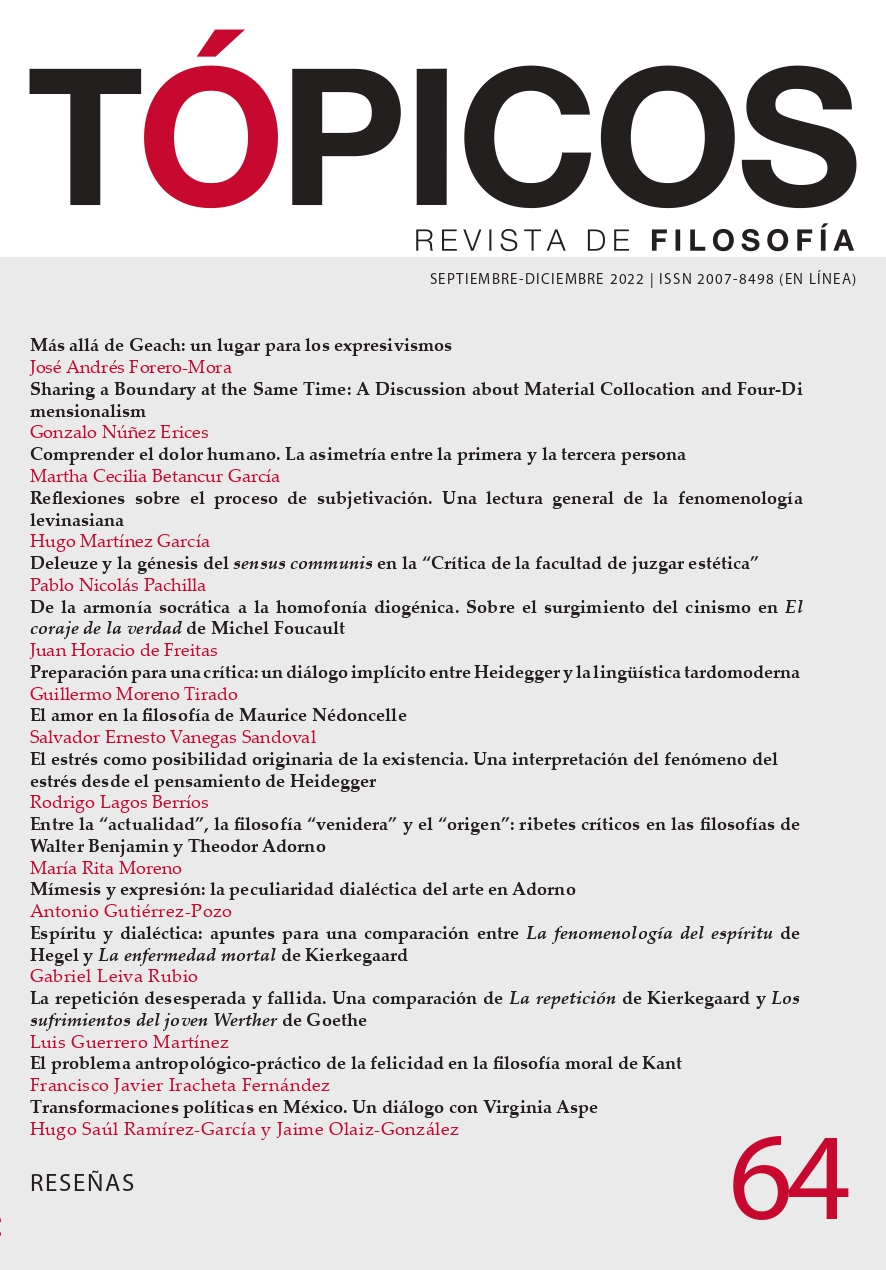Publicado 2022-08-13
Palabras clave
- arte,
- dialéctica,
- mímesis,
- expresión,
- filosofía
Derechos de autor 2022 Tópicos, Revista de Filosofía

Esta obra está bajo una licencia internacional Creative Commons Atribución-NoComercial-SinDerivadas 4.0.
Cómo citar
Resumen
Este artículo muestra que, para Adorno, el arte es conocimiento, tiene importancia gnoseológica y está vinculado a la verdad. Mientras que Adorno hace una separación y distinción radical entre arte y filosofía, al mismo tiempo asegura que mantienen una relación de complementación y colaboración. Esta relación solo puede fundamentarse en la comprensión del arte como dialéctica y como extrañamiento del mundo real. Este vínculo dialéctico con la realidad concreta funda dos conceptos estéticos que caracterizan el modo peculiar de pensar en el arte, a saber, “mímesis” y “expresión”. Después de tratar con la condición mimético-expresiva del arte, el artículo esclarece la relación de complementariedad entre el arte y la filosofía.
Descargas
Referencias
- Adorno, T. ([1931] 1979). Kierkegaard. Konstruktion des Ästhetischen. Gesammelte Schriften. 2. Suhrkamp.
- Adorno, T. ([1947] 1984). Dialektik der Aufklärung. Gesammelte Schriften. 3. Suhrkamp.
- Adorno, T. ([1958-1959] 2009). Ästhetik (1958-59). Nachgelassene Schriften. Abteilung IV: Vorlesungen. Band 3. Suhrkamp.
- Adorno, T. ([1962-1964a] 1997). Philosophische Terminologie. Zur Einleitung. I. Suhrkamp.
- Adorno, T. ([1962-1964b] 1997). Philosophische Terminologie. Zur Einleitung. II. Suhrkamp.
- Adorno, T. ([1966] 1977). Negative Dialektik. Gesammelte Schriften. 6. Suhrkamp.
- Adorno, T. ([1969] 1984). Ästhetische Theorie. Gesammelte Schriften. 7. Suhrkamp.
- Brunkhorst, H. (2017). Die Dialektik der Aufklärung nach siebzig Jahren. En G. Hindrichs (ed.), M. Horkheimer / Theodor W. Adorno: Dialektik der Aufklärung. (pp. 179-197). De Gruyter.
- Di Cesare, D. (2009). Gadamer – Ein philosophisches Porträt. Mohr Siebeck.
- Gadamer, H.-G. ([1967] 1993). Kunst und Nachahmung. En Gesammelte Werke. Band 8. Ästhetik und Poetik. I. Kunst als Aussage. (pp. 25-36). Mohr Siebeck.
- Gadamer, H.-G. ([1972] 1993). Dichtung und Mimesis. En Gesammelte Werke. Band 8. Ästhetik und Poetik I. Kunst als Aussage. (pp. 80-85). Mohr Siebeck.
- Gandesha, S. (2004). Leaving Home. On Adorno and Heidegger. En T. Huhn (ed.), The Cambridge Companion to Adorno. (pp. 101-128). Cambridge University Press.
- Geulen, E. (2004). Adorno’s Aesthetic Theory. En T. Huhn (ed.), The Cambridge Companion to Adorno. (pp. 397-411). Cambridge University Press.
- Hegel, G. W. F. ([1817-1831] 1986). Enzyklopädie der philosophischen Wissenschaften. I. Werke. 8. Suhrkamp.
- Hegel, G. W. F. ([1818-1829] 1986). Vorlesungen über die Ästhetik. I. Werke. 13. Suhrkamp.
- Heidegger, M. ([1935] 1977). Der Ursprung des Kunstwerkes. En Gesamtausgabe. I. Abteilung: Veröffentlichte Schriften 1910–1976. Band 5. Holzwege. (pp. 1-74). Vittorio Klostermann.
- Hegel, G. W. F. ([1938] 1977). Die Zeit des Weltbildes. En Gesamtausgabe. I. Abteilung: Veröffentlichte Schriften 1910–1976. Band 5. Holzwege. (pp. 75-113). Vittorio Klostermann.
- Hegel, G. W. F. ([1943] 1977). Nietzsches Wort Gott ist tot. En Gesamtausgabe. I. Abteilung: Veröffentlichte Schriften 1910–1976. Band 5. Holzwege. (pp. 209-267). Vittorio Klostermann.
- Hegel, G. W. F. ([1947] 1983). Aus der Erfahrung des Denkens. En Gesamtausgabe. I. Abteilung: Veröffentlichte Schriften 1910–1976. Band 13. Aus der Erfahrung des Denkens (1910-1976). (pp. 75-86). Vittorio Klostermann.
- Hegel, G. W. F. ([1953] 2000). Die Frage nach der Technik. En Gesamtausgabe. I. Abteilung: Veröffentlichte Schriften 1910–1976. Band 7. Vorträge und Aufsätze. (pp. 5-36). Vittorio Klostermann.
- Huhn, T. (2004). Introduction. Thoughts beside Themselves. En T. Huhn (ed.), The Cambridge Companion to Adorno. (pp. 1-18). Cambridge University Press.
- Kant, I. ([1790] 1990). Kritik der Urteilskraft. Felix Meiner.
- Knatz, L. (1998). Die Philosophie der Kunst. En H. J. Sandkühler (ed.), F. W. J. Schelling. (pp. 109-123). J. B. Metzler.
- Lear, G. R. (2006). Plato on Learning to Love Beauty. En G. Santas (ed.), The Blackwell Guides to Plato’s Republic. (pp. 104-125). Blackwell.
- Platón. (1938). Œuvres complètes. Tome IV, 2e partie. Le banquet (Συηπόσιον).Les Belles Lettres.
- Sallis, J. (2007). The Hermeneutics of the Artwork (GW 1, 87-138). En G. Figal (ed.), H.-G. Gadamer: Wahrheit und Methode. (pp. 45-58). Akademie Verlag.
- Schelling, F. W. J. ([1800] 2005). System des transzendentalen Idealismus. Werke. Band 9-1. Frommann-Holzboog.
- Schneider, W. (1983). Ästhetische Ontologie. Schellings Weg des Denken zur Identitätsphilosophie. Peter Lang.
- Sherratt, Y. (2002). Adorno’s Positive Dialectic. Cambridge University Press.
- Silberbusch, O. C. (2018). Adorno’s Philosophy of the Nonidentical. Thinking as Resistance. Palgrave Macmillan.
- Spencer, H. ([1855] 1966). The Works of Herbert Spencer. The Principles of Psychology. II. Otto Zeller.
- Vattimo, G. (1985). Poesia e ontologia. Mursia.





